Caltrans
R a i l 

 D
i v i s i o n
D
i v i s i o n
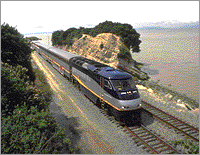
Amtrak California Photo |
|
An unoffical history of the California
Department of Transportation's Rail Division
by Ken Rattenne
Photography by the author except where
noted
NOTE: This article was written in
1997 and has not been updated since then. Roster information updated through
2015.
Introduction
Since 1982 the California
Department Of Transportation (CalTrans) has been active in the funding,
planning and execution of a number of railroad passenger operations in
the Golden State. CalTrans' Rail Division, in a partnership with Amtrak,
has expanded California's rail transportation network dramatically, adding
several new trains to the San Diegan and San Joaquin corridors and
initiating the very popular Capitols between San Jose and Sacramento.
Until 1992 CalTrans
also operated CalTrain, the former Southern Pacific commuter service
on the San Francisco Peninsula crewed by Amtrak personnel. During this
period they increased the number of trains to 60 a day, refurbished stations
and purchased new equipment.
CalTrain is now operated
as a separate entity governed by the Joint Powers Board representing the
three participating counties: Santa Clara. San Mateo and San Francisco.
Equipment, however, retains the CDTX reporting marks designation.
Due to the Great Recession,
in 2010 the Joint Powers Board was receiving only a fraction of the funding
required tokeep service as described above, due mostly to reduces tax revenues.
The JPB announced drastic service reductions to take place starting in
October of 2010 and January of 2011. Weekend service would be eliminated
as would service to Gilroy. |
The
Caltrain
Years

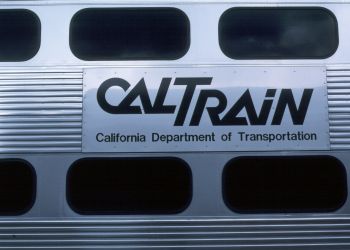
In 1980 the California
Department of Transportation (Caltrans) took over operation of Southern
Pacific's San Francisco-to-San Jose commuter service, leasing the passenger
cars, locomotives and stations along the line from SP and contracting with
SP for operations. Under the moniker of Caltrain, the agency was successful
in building ridership and adding trains to improve overall service. In
1985 Caltrans re-equipped the service with brand new stainless steel bilevel
cars and head-end power equipped locomotives.
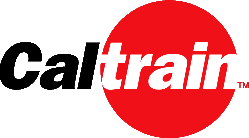 On
June 27, 1992, Caltrain service. equipment and physical plant were turned
over to the Bay Area's Joint Powers Board (JPB), an independent governing
agency formed to administer all aspects of Caltrain Peninsula commuter
operations.
On
June 27, 1992, Caltrain service. equipment and physical plant were turned
over to the Bay Area's Joint Powers Board (JPB), an independent governing
agency formed to administer all aspects of Caltrain Peninsula commuter
operations.
Today, the JPB operates
autonomously, responsible for all Caltrain operations, maintenance and
funding activities. Asidefrom loaning an occasional F40PH-2 to the state
to cover an Amtrak road failure, there is no day-to-day contact with Caltrans.

Caltrans And Amtrak
California
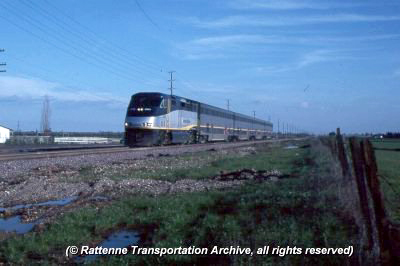
Once out of the commuter
rail business, Caltrans began focusing on building a state-wide intercity
rail service to meet the needs of a growing rail passenger market and to
begin an aggressive campaign to convince more Californians to leave the
convenience of their cars for the convenience and comfort of an Amtrak
coach. To this end CalTrans and Amtrak entered into a partnership called
Amtrak California.
Today, Caltrans and Amtrak
California is responsible for California's three busiest rail corridors:
The Capitol Corridor Service, San Joaquins and San Diegans -
since
renamed to Surfliners. Through Caltrans funding, Amtrak operates
an extensive state-wide network of Amtrak Thruway bus connections which
act as a feeder system to the trains. This bus-rail pairing brings intercity
transportation to many of California's smaller towns that have no direct
Amtrak rail connection.
The Department must also
employ political savvy as well as logistical expertise, cooperating with
local government agencies to provide grants for station improvements in
addition to money for capital improvements to track and signaling systems
on routes running Amtrak trains.
The Caltrans Rail Division
has been using bond money voted for rail use in 1990, and has used these
funds for adding to train frequency on all three corridors plus extending
Surfliner service on California's scenic Coast Line between San Luis Obispo
and Los Angeles. This bond money was also used by Caltrans to design and
purchase a new fleet of intercity railcars and locomotives now plying California's
rails. Dubbed "California Cars," these new bilevel passenger cars equip
all state-funded corridor trains.

Equipment
Caltrans purchased its first
railroad passenger equipment in 1984 and 1986 when it funded 20 EMD F40PH-2
locomotives and 60 bilevel gallery coaches to be used in Peninsula commuter
service. Title to this equipment was transferred to the Peninsula Corridor
Joint Powers Board (JPB) in 1992 and no longer appears on any Caltrans
roster.
In 1991 Caltrans ordered
two General Electric P32-8WH units as part of a larger Amtrak order for
the same model. These two units originally wore Amtrak colors and featured
a small Caltrans decal on the cab. They carried Amtrak numbers 501-502
until 1994 when the units were repainted into the current Amtrak California
paint scheme and renumbered 2051-2052.
|
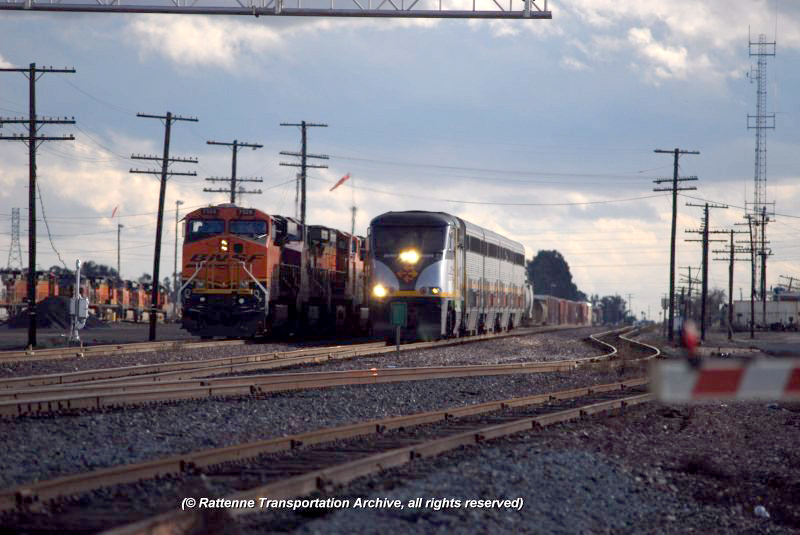 |
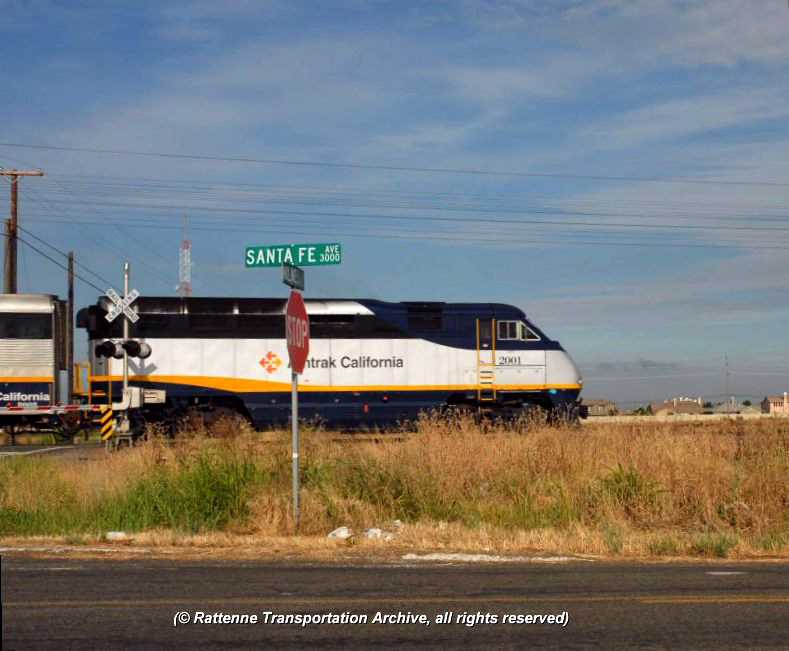 |
| Amtrak
California F59PHI 2009 passes a BNSF freight as it speeds through
Riverbank Yard with a northbound San Joaquin on December 12, 2008.
Six months later the San Joaquin has just left the Modesto depot
and will run along the aptly named Santa Fe Road for another mile. The
San
Joaquins uses BNSF tracks between Port Chicago and Bakersfield, maintaining
a respectable 79 mph along much of the route. BNSF does a better than average
job keeping the trains' schedules. |
In 1995 Caltrans ordered and
took delivery of 9 EMD F59PHI passenger locomotives that were quickly pressed
into service on Capitol Corridor and San Joaquin trains.
Amtrak ordered the same model for the Surfliner corridor, wearing a unique
blue and silver paint scheme. In addition to locomotives, 1995 also found
Caltrans taking delivery of their long-awaited bilevel California Cars
constructed by Morrison/Knudsen and used exclusively on the Capitol
Corridor and San Joaquin trains.
With the growing popularity
of both the San Joaquin and Capitol Corridor trains Caltrans
went back to EMD in 2001 and ordered another six F59PH units, numbered
2010-2015.

Caltrans
Locomotive Roster Summary
The below roster is effective
as of November 1996. The CalTrain F40PH-2s, though no longer part of the
Caltrans equipment roster, are nonetheless presented here since they were
originally purchased by the agency. They are currently owned by the Joint
Powers Board.
The F59PHI and P32-8WH
units make up the majority of the roster but Amtrak G.E. P42 units often
are assigned to Capitol Corridor and San Joaquin service when the Amtrak
California units are in for inspection. Amtrak maintains the Amtrak
California roster at their Oakland maintnance base.
Amtrak California & Joint Powers Board Locomotive
Roster Summary
Compiled by Ken Rattenne
|
| Owner |
Road No.
|
Qty
|
Model
|
HP
|
Blt
|
Note |
| JPBX |
|
18
|
F40PH-2 |
3000
|
1985
|
lettered for CalTrain service |
| JPBX |
|
2
|
F40PH-2 |
3000
|
1987
|
lettered for CalTrain service |
| JPBX |
|
3
|
F40PH-2C |
3000
|
?
|
lettered for CalTrain service |
| JPBX |
|
6
|
MP36PH-3C |
3600 |
2004 |
lettered for CalTrain service |
| JPBX |
|
2
|
SW1500 |
1500 |
1974 |
ex-Southern Pacific |
| JPBX |
|
2 |
GP9R |
1750 |
1959 |
ex-SP 3833 & 3842 |
| CDTX |
|
9
|
F59PHI |
3200
|
1995
|
lettered for Amtrak California |
| CDTX |
|
6
|
F59PHI |
3200
|
2001
|
lettered for Amtrak California |
| CDTX |
|
2
|
P32-8WH |
3200
|
1991
|
ex-AMT 501-502, lettered
for Amtrak California |
Reporting marks for all units is CDTX
Notes
-
CalTrans transferred title to 900-919 to the JPB (Joint Powers
Board) in 1992). JPB has since taken delivery of three additional units.
-
CalTrain F40PH-2s were not equipped with dynamic braking
upon delivery but have since been equipped with that feature when the fleet
was rebuilt.
-
CalTrans 2051-2052 were originally delivered lettered and
painted for Amtrak, wearing numbers 501-502. The only distinguishing marking
was a Caltrans logo on the cab of each unit. The units were painted into
the Amtrak California silver & blue scheme in the summer of 1995.
See a Detailed
Roster (unit-by-unit)

Photo Gallery
Photos by Ken Rattenne
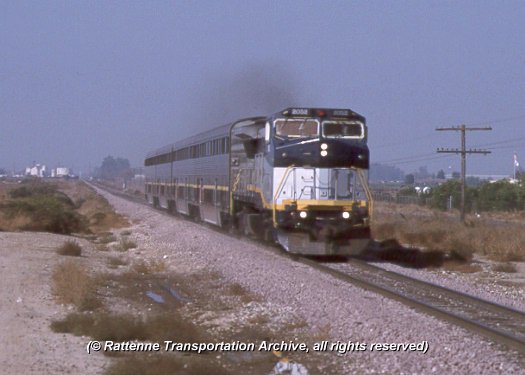 |
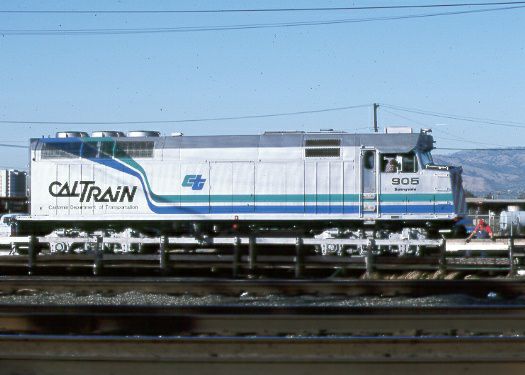
|
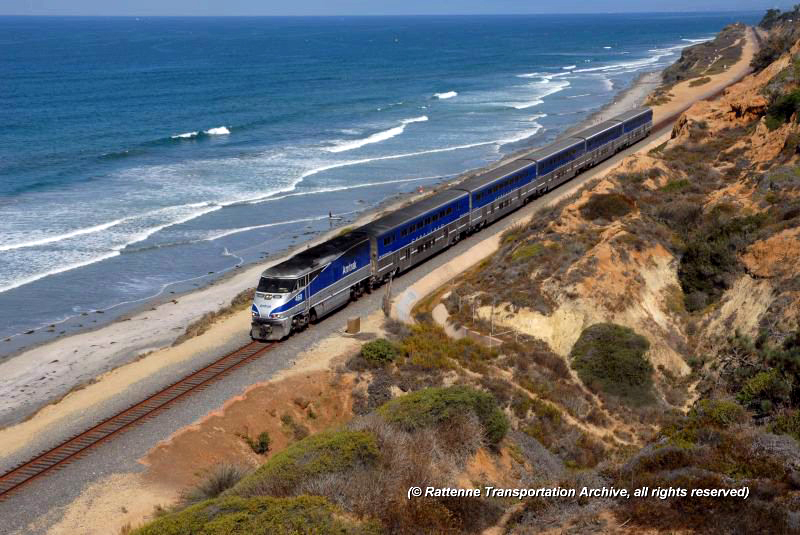 |
| On October 27, 1998, B32-8WH
2052 (ex-Amtrak 502) blasts through Modesto with a set of California Cars
after departing Riverbank only moments before with the San Joaquin.
. (Ken Rattenne Photo) |
CalTrain 1985-built F40PH-2
905 takes its turn on the turntable in San Jose not long after its delivery.
(Ken
Rattenne Photo) |
Amtrak F59PH 460 speeds
a Surfliner south through Del Mar on September 19, 2008. Theformer
San Diegan train name was changed to Surfliner when Amtrak California rebranded
the service and added California Cars. The F59s belong to Amtrak. |
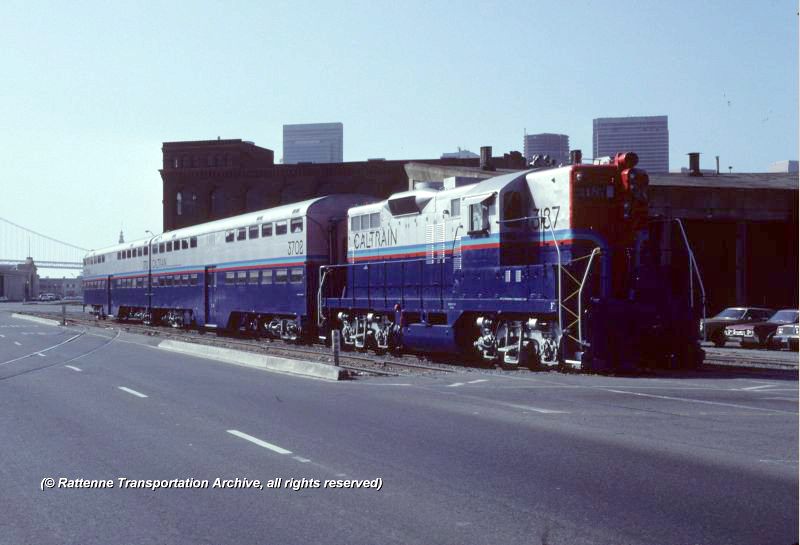
CalTrain (nee SP) 3i87 displays
its one of a kind paint scheme along with two of three bilevels which also
wore the experimental scheme. Seldom did the four travel in a matched set
but it did occasionally happen. Seen here on display in San Francisco on
May 15, 1982. |
Southern
Pacific GP9E 3187 and three SP Gallery cars were repainted into an
experimental CalTrain paint scheme in 1983. SP, which held the operating
contract for CalTrain, wasn't particularly interested in keeping the matched
set together and more often than not passenger cars and locomotive were
scattered amongst four different trains. However, once in a great while
the gods would smile and the 3187 would pull duty with the three matched
Gallery cars.
CalTrans returned
3187 to SP in 1985 after taking delivery of new F40PH-2s. SP immediately
re-assigned the 3187 to the general freight pool and the unit finished
out its days working locals and yards. |

A Capitol Corridor train
with CDTX 2011 in the lead, trundles across the Carquinez Straits just
before arriving at Martinez on April 28, 2002. |
| Links
Want to learn more about California
intercity passenger rail service,
CalTrain or Bay Area railroad
history? Check out these quality links.
|
 CalTrain Baby Bullet
Train, Santa Clara
CalTrain Baby Bullet
Train, Santa Clara
|

 Rattenne
Family Of Pages
Rattenne
Family Of Pages
Created: February 23,
1996. Last Updated: February 2022.
This document is Copyright
©1997-2022 by Ken Rattenne and KPR
Media Services


 On
June 27, 1992, Caltrain service. equipment and physical plant were turned
over to the Bay Area's Joint Powers Board (JPB), an independent governing
agency formed to administer all aspects of Caltrain Peninsula commuter
operations.
On
June 27, 1992, Caltrain service. equipment and physical plant were turned
over to the Bay Area's Joint Powers Board (JPB), an independent governing
agency formed to administer all aspects of Caltrain Peninsula commuter
operations.









 Rattenne
Family Of Pages
Rattenne
Family Of Pages